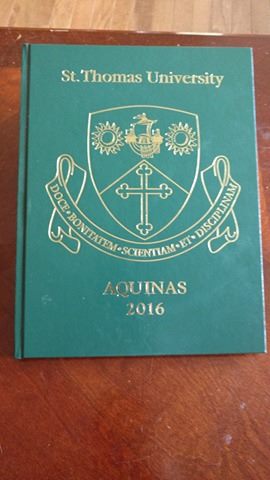

After being ruled out as a financial hurdle, St. Thomas University’s yearbook is on its way to becoming less of a physical memento and more of a modern keepsake.
The St. Thomas University Students’ Union will be creating a digital yearbook this year, and editor Ayla Poitras said the goal is to have a more “economic and environmentally friendly yearbook.”
“While people still read books and we still hand in paper essays, it was about time that the yearbook became something a little more cost effective,” she said.
Poitras said finding sponsorships and advertisements for the yearbook in its original hard copy form was “next to impossible.” She said shifting the yearbook to digital form will cost STUSU next to nothing and students will not need to purchase it.
Philippe Ferland, STUSU vice-president administration, said the online yearbook is meant to offer the same opportunity to reminisce, just through a different medium.
“The main underlying problem was whether or not we should continue to invest such a large amount of money into a project that no longer holds very much relevance in today’s day and age,” Ferland said.
“Moving to an electronic yearbook is what we saw as the correct way to fulfill the purpose of a yearbook, while eliminating the problems associated with creating physical yearbooks.”
First-year student Brianna McQuillan said she was sad to hear hard copies of the yearbook would no longer be available.
“I mean, it does make sense but at the same time not everyone is going to have access to look at the online one,” she said. “Like, grandparents and other people in your family you might want to show who wouldn’t have access to the web to be able to look at it.”
McQuillan said being able to have a hard copy would be ideal, and even with the non-existent price, she felt many people would still like to have a real book.
“I think the hard copy is much better even with a price because it is something you get to hold onto forever,” said McQuillian.
Ferland said over the past two years STUSU spent $7000 on yearbooks. However, that amount is only a portion of what it takes to cover the entire cost of creating, manufacturing and delivering the book.
“The rest is meant to be covered by sponsorships,” Ferland said. “Here is the problem. Businesses do not want to advertise [in] yearbooks anymore. This is because they don’t offer the kind of exposure that makes investing into them worth it.”
While Poitras said she knows many students will be upset to learn the yearbook will no longer be available in hard copy, she understands the economic and environmental advantages to going digital.
“It was something that had to be done,” she said. “If it didn’t happen this year, it would happen next year or the year after.”
